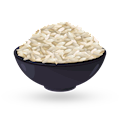MAIN INGREDIENTS
Lomo a la pobre or bistec a lo pobre is a large meal similar to Chorrillana that is popular in Chile and Peru. In its basic form, the meal consists of steak, fried onions, fried potatoes, fried eggs, and rice. A large beef steak (usually rubbed with garlic) is fried, then topped with fried eggs with runny yolks, while onions and potatoes are served on the side.
The name of this meal translates to poor man's steak, despite the fact that this dish is hearty and very nutritious. In Chile and Peru, it is almost always served for lunch.
Cordero al palo is a traditional lamb specialty that involves roasting a whole lamb on a spit, a cooking technique which has long been practiced in Chile and Argentina (especially Patagonia). The lamb is slowly cooked for several hours over a wood fire, all the while basting in its own juices and fat, resulting in succulent and tender meat surrounded by crispy skin.
While cooking, the meat is often enhanced with a mixture of warm water, salt, and garlic. The dish can be found on the menus of numerous restaurants throughout the region, and it is typically served with pebre, a popular Chilean condiment.
Other typical accompaniments to this dish include boiled potatoes, fresh salads, bread, and lots of fine red wine.
MOST ICONIC Cordero al palo
View moreMAIN INGREDIENTS
Chorrillana or bistec a la chorrillana is a popular Chilean dish served mostly in pubs where it is labeled as an appetizer or a dish that is meant to be shared. The basis of the meal are French fries which are covered in a combination of fried or scrambled eggs, strips of beef, and caramelized onions.
Common variations include additional ingredients like hot dogs, chorizo, and tomatoes, while the seasonings may include either garlic, oregano, or pebre—a popular Chilean condiment.
MOST ICONIC Chorrillana
View morePollo arvejado is a typical Chilean stew made with chicken and peas as the main ingredients. The stew is usually flavored with onions, garlic, carrots, green peppers, white wine, chicken stock, cumin, paprika, and bay leaves. In Chile, it is typically accompanied by rice or potatoes.
This comforting dish is quite popular in the country because it is quick and easy to prepare while remaining immensely flavorful.
MAIN INGREDIENTS
Pollo al cognac is a traditional chicken dish originating from Chile. The dish is usually made with a combination of chicken pieces, cognac, crushed garlic, white wine, butter, bay leaves, salt, and pepper. The skin is removed from the chicken and the meat is then browned in butter and seasoned with salt and pepper.
The white wine, cognac, garlic, and bay leaves are added to the pot and the dish is then simmered over low heat for more than an hour, until everything is tender and juicy. It's recommended to serve the dish with fries or rice on the side.
MAIN INGREDIENTS
Curanto is a traditional technique of cooking meat and seafood originating from Chiloé. In order to prepare it, chicken, pork, sausages, seafood (clams, mussels, giant barnacles), chapaleles potato dumplings, potatoes, and various vegetables are placed in a pit that's lined with curanto, meaning hot stones.
Each layer of the ingredients is topped with large nalca (Chilean rhubarb) leaves that keep the steam trapped inside. Once cooked, the meat and seafood are usually served with pebre, hot sauce, and milcao potato pancakes. Ideally, the feast should be paired with a pisco sour for an authentic experience.
MAIN INGREDIENTS
Tasty, easy to prepare, and quite inexpensive, cazuela de ave is a Chilean chicken stew consisting of chicken pieces, chicken stock, onions, carrots, pumpkin or squash, potatoes, rice, and pieces of corn. The stew is most commonly flavored with garlic, salt, pepper, coriander, and paprika powder.
After it has been prepared, cazuela de ave is traditionally served in a red clay pot known as greda. The succulent chicken should fall off the bone, while the vegetables should be sweet and soft, almost melting in the mouth. It is believed that this dish was derived from the indigenous Mapuche soup known as corri.
Niños envueltos (lit. wrapped children) is a traditional dish consisting of rice and ground beef that are wrapped in cabbage and cooked in tomato sauce. Apart from the main ingredients, the dish also often contains garlic, basil, bell peppers, and onions, while the tomato sauce is made with olive oil, tomatoes, garlic, oregano, sugar, salt, and pepper.
The dish is slowly simmered until the cabbage becomes tender and the rolls are fully cooked. The rolls are often served with bread and a fresh salad on the side. It is believed that this dish is actually a Dominican adaptation of Middle Eastern dishes which were brought to the country by immigrants in the 19th century.
MAIN INGREDIENTS
Carbonada chilena is a traditional brothy stew originating from Chile. The soup-like stew is usually prepared with a combination of beef (often chuck roast), potatoes, carrots, bell peppers, celery, onions, pumpkin, corn, peas, garlic, paprika, oregano, beef stock, bay leaves, salt, pepper, and olive oil.
The ingredients are placed in a pot and simmered until the vegetables become tender and the meat is fully cooked. If desired, some cooked rice can be spooned over the dish before serving. This nourishing stew is ideal for colder days in autumn or winter, when it's eaten as comfort food.
MAIN INGREDIENTS
Charquicán is a flavorful Chilean stew that was originally made with dried and salted llama meat, pumpkin, onions, sweet corn, and potatoes as its main ingredients. Modern versions often employ ground beef instead of dried llama meat (due to its strong flavor) and top the dish with a fried egg.
The name of the dish is derived from the Quechua and Mapuche word charqui, which means jerky. Apart from Chile, this hearty stew is also popular in Bolivia, Argentina, and Peru.
TasteAtlas food rankings are based on the ratings of the TasteAtlas audience, with a series of mechanisms that recognize real users and that ignore bot, nationalist or local patriotic ratings, and give additional value to the ratings of users that the system recognizes as knowledgeable. TasteAtlas Rankings should not be seen as the final global conclusion about food. Their purpose is to promote excellent local foods, instill pride in traditional dishes, and arouse curiosity about dishes you haven’t tried.















